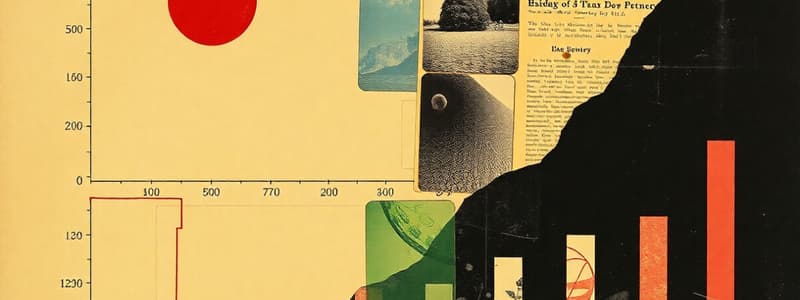Podcast
Questions and Answers
In hypothesis testing, what is the primary characteristic of the null hypothesis ($H_0$)?
In hypothesis testing, what is the primary characteristic of the null hypothesis ($H_0$)?
- It is what the researcher typically hopes to accept.
- It represents a neutral assumption or no effect. (correct)
- It always aims to prove a specific claim.
- It contains an inequality sign ($>$ or $<$).
A researcher sets the level of significance (alpha, $\alpha$) at 0.05. What does this signify in the context of hypothesis testing?
A researcher sets the level of significance (alpha, $\alpha$) at 0.05. What does this signify in the context of hypothesis testing?
- There is a 95% chance of rejecting the null hypothesis when it is false.
- There is a 5% chance of falsely rejecting the null hypothesis. (correct)
- There is a 5% chance of falsely accepting the null hypothesis.
- There is a 95% chance that the alternative hypothesis is true.
Under what conditions is a one-tailed hypothesis test most appropriate?
Under what conditions is a one-tailed hypothesis test most appropriate?
- When the sample size is small.
- When you only care about differences in one direction (either greater than OR less than). (correct)
- When the population standard deviation is unknown.
- When you want to determine if the sample mean is different from the population mean.
A researcher is testing a hypothesis about the average height of adult women. The alternative hypothesis is that the average height is not equal to 5'4". Which type of hypothesis test should be used?
A researcher is testing a hypothesis about the average height of adult women. The alternative hypothesis is that the average height is not equal to 5'4". Which type of hypothesis test should be used?
What is the general guideline for using a Z-test instead of a t-test? (Assume all other assumptions for both tests are met.)
What is the general guideline for using a Z-test instead of a t-test? (Assume all other assumptions for both tests are met.)
A college wants to survey its students about their satisfaction with campus services. The college has 5,000 students, and they want to survey a representative sample of 500 students. Using the formula provided, what calculation would determine the number of students to select from each department?
A college wants to survey its students about their satisfaction with campus services. The college has 5,000 students, and they want to survey a representative sample of 500 students. Using the formula provided, what calculation would determine the number of students to select from each department?
In the context of hypothesis testing, what does it mean to 'formulate a decision rule'?
In the context of hypothesis testing, what does it mean to 'formulate a decision rule'?
A pharmaceutical company claims their drug takes an average of 18 minutes to take effect, with a standard deviation of 2 minutes. A sample of 36 trials shows an average of 20 minutes. If you test the claim (at α = .01) that the average time is not equal to 18 minutes, which test statistic would be most appropriate, and what values are needed to calculate it?
A pharmaceutical company claims their drug takes an average of 18 minutes to take effect, with a standard deviation of 2 minutes. A sample of 36 trials shows an average of 20 minutes. If you test the claim (at α = .01) that the average time is not equal to 18 minutes, which test statistic would be most appropriate, and what values are needed to calculate it?
A researcher wants to determine the average income of households in a city. Which descriptive statistic would be most appropriate to use?
A researcher wants to determine the average income of households in a city. Which descriptive statistic would be most appropriate to use?
A dataset of test scores has a mean of 75 and a standard deviation of 5. A student scored 85 on the test. What is the student's z-score?
A dataset of test scores has a mean of 75 and a standard deviation of 5. A student scored 85 on the test. What is the student's z-score?
In a dataset of employee salaries, the median salary is $60,000. What does this indicate?
In a dataset of employee salaries, the median salary is $60,000. What does this indicate?
A company wants to assess customer satisfaction using a survey. They randomly select customers from their database and ask them to rate their satisfaction on a scale of 1 to 5. What sampling method is being used?
A company wants to assess customer satisfaction using a survey. They randomly select customers from their database and ask them to rate their satisfaction on a scale of 1 to 5. What sampling method is being used?
A researcher is studying the prevalence of a rare disease. They start with a few known cases and then ask those individuals to refer other potential participants who may also have the disease. Which sampling technique is being used?
A researcher is studying the prevalence of a rare disease. They start with a few known cases and then ask those individuals to refer other potential participants who may also have the disease. Which sampling technique is being used?
A market researcher wants to gather data on consumer preferences for different brands of coffee. They stand outside a coffee shop and ask every 10th person who exits the shop about their coffee preferences. Which sampling technique is being used?
A market researcher wants to gather data on consumer preferences for different brands of coffee. They stand outside a coffee shop and ask every 10th person who exits the shop about their coffee preferences. Which sampling technique is being used?
A university wants to survey its students about their opinions on a new policy. The student population is divided into different colleges (e.g., Arts, Sciences, Engineering), and a random sample is taken from each college. Which sampling technique is being used?
A university wants to survey its students about their opinions on a new policy. The student population is divided into different colleges (e.g., Arts, Sciences, Engineering), and a random sample is taken from each college. Which sampling technique is being used?
A researcher is conducting a study on the effectiveness of a new teaching method. They divide the student population into several classes (clusters) and then randomly select a few of these classes to participate in the study. All students in the selected classes are included in the sample. Which sampling technique is being used?
A researcher is conducting a study on the effectiveness of a new teaching method. They divide the student population into several classes (clusters) and then randomly select a few of these classes to participate in the study. All students in the selected classes are included in the sample. Which sampling technique is being used?
A researcher uses Slovin's formula to calculate the required sample size for a study. If the population size is 1000 and the desired margin of error is 5%, what is the required sample size?
A researcher uses Slovin's formula to calculate the required sample size for a study. If the population size is 1000 and the desired margin of error is 5%, what is the required sample size?
What is the primary difference between probability and non-probability sampling?
What is the primary difference between probability and non-probability sampling?
In a dataset, the first quartile (Q1) is 20 and the third quartile (Q3) is 40. What is the interquartile range (IQR)?
In a dataset, the first quartile (Q1) is 20 and the third quartile (Q3) is 40. What is the interquartile range (IQR)?
Which of the following data gathering methods is best suited for examining the cause and effect of a specific intervention?
Which of the following data gathering methods is best suited for examining the cause and effect of a specific intervention?
A quality control manager wants to identify unusually high or low values in a production dataset. Which statistical measure would be most helpful in this scenario?
A quality control manager wants to identify unusually high or low values in a production dataset. Which statistical measure would be most helpful in this scenario?
A retail store wants to determine the typical spending amount of its customers. They calculate the weighted mean, considering both the amount spent per visit and the frequency of visits. Why is the weighted mean more appropriate than the regular mean in this case?
A retail store wants to determine the typical spending amount of its customers. They calculate the weighted mean, considering both the amount spent per visit and the frequency of visits. Why is the weighted mean more appropriate than the regular mean in this case?
A market research team is tasked with gathering in-depth qualitative data about consumer preferences for a new product line. They need to understand not just what consumers think, but why they think that way. Which data gathering method would be most suitable for this purpose?
A market research team is tasked with gathering in-depth qualitative data about consumer preferences for a new product line. They need to understand not just what consumers think, but why they think that way. Which data gathering method would be most suitable for this purpose?
Flashcards
Mean
Mean
Average of all data values.
Weighted Mean
Weighted Mean
Average, considering the 'weight' or importance of each value.
Median
Median
Middle value when data is ordered.
Mode
Mode
Signup and view all the flashcards
Percentile
Percentile
Signup and view all the flashcards
Quartile
Quartile
Signup and view all the flashcards
Interquartile Range
Interquartile Range
Signup and view all the flashcards
Range
Range
Signup and view all the flashcards
Sample Variance
Sample Variance
Signup and view all the flashcards
Standard Deviation
Standard Deviation
Signup and view all the flashcards
Z-score
Z-score
Signup and view all the flashcards
Outlier
Outlier
Signup and view all the flashcards
Sampling
Sampling
Signup and view all the flashcards
Simple Random Sampling
Simple Random Sampling
Signup and view all the flashcards
Systematic Sampling
Systematic Sampling
Signup and view all the flashcards
Hypothesis
Hypothesis
Signup and view all the flashcards
Statistical Hypothesis
Statistical Hypothesis
Signup and view all the flashcards
Steps in Hypothesis Testing
Steps in Hypothesis Testing
Signup and view all the flashcards
Null Hypothesis (Ho)
Null Hypothesis (Ho)
Signup and view all the flashcards
Alternative Hypothesis (Ha)
Alternative Hypothesis (Ha)
Signup and view all the flashcards
Level of Significance (α)
Level of Significance (α)
Signup and view all the flashcards
One-Tailed Test
One-Tailed Test
Signup and view all the flashcards
Two-Tailed Test
Two-Tailed Test
Signup and view all the flashcards
Study Notes
- Descriptive Statistics describe data.
Kinds of Descriptive Statistics
- Mean is the average of all data.
- Weighted mean involves multiplying the cost per pound by the number of pounds, totaling the answers, and then dividing by the total pounds.
- Median is the value in the middle when values are in ascending order.
- For an odd number of values, the median is the middle number.
- For an even number of values, the median is the average of the two middle numbers.
- Mode is the most frequent value in the data set.
- Percentile can be found using the Excel function "=PERCENTILE.EXC(data range, p/100)".
- Quartile can be found using the Excel function "=QUARTILE.EXC(array, QUART)".
- Interquartile Range can be found using the Excel function "= 3rd Quartile - 1st Quartile".
- Range is the largest value minus the smallest value.
- Sample Variance can be found using the Excel function "=VAR.S(data cell range)".
- Standard Deviation can be found using the Excel function "=STDEV.S(data cell range)".
- Z-score is a standardized value and a measure of the relative location of an observation in a data set.
- Outlier is an unusually small or large value in a data set.
Sampling Methods
Methods
- Interview involves face-to-face data gathering.
- Survey utilizes a pen and paper method.
- Registration involves documentary analysis.
- Observation involves observing attitudes, behaviors, and values.
- Experimentation involves controlling factors affecting the variable being studied and examines cause and effect of a certain phenomena.
- Sampling draws a sample from a population, applied when entire elements of population are unavailable or too large.
Sampling Techniques
- Probability involves randomly selecting participants.
- Non-probability involves selecting participants based on factors such as convenience or willingness to participate.
Probability Sampling
- Simple Random sampling has every member with an equal chance of being selected using a random process.
- Systematic sampling selects every NTH member in this method.
- For example, every 5th person is interviewed.
- Stratified sampling depends on location/gender/any category and divides the population into homogenous subgroups called strata or something in common.
- Cluster sampling divides into clusters/groups.
- Then selecting using a random process.
- Multi-stage sampling is a combination of two or more techniques.
Non Probability Sampling
- Convenience is based on availability/accessibility.
- Quota samples participants are selected until a quota is reached.
- This involves non-random selection and so will select regardless of college, rank, age, etc, to reach a goal.
- Snowball is selecting first using a non-probability method where selected individuals are asked to refer others.
- Purposive samples using a qualifying question to pick depending on what they already experienced.
- If yes, you pick them.
Calculating Sample Size
- By percentage, use 10% for a very large population and 20% for a small population.
- Slovin's formula is n = N / (1 + Ne^2), where n = sample size, e = margin of error, and N = population size.
- Cochran's formula is used to determine the number of students that must be taken from each college of a certain university, if a 5% margin of error is to be considered.
- To find the selected in each college: Each college/Total population x Sample size.
Hypothesis Testing
- Hypothesis is an assumption about the population parameter that's an educated and unbiased guess while making an inference/generalization.
- Statistical Hypothesis is a guess/prediction regarding a possible outcome.
Steps in Hypothesis Testing
- Formulate
- Ho - null hypothesis (neutral assumptions)
- Ha - alternative hypothesis
- Set level of significance
- Formulate decision rule (reject or accept hypothesis) based on critical value (P value)
- Do computation
- Make decision
- Write conclusion
Types of Statistical Hypotheses
- Null is always hoped to be rejected, contains = sign, and is the one trying to be disproved.
- Alternative challenges null, never contains = sign, uses > or < or "not equal", generally represents the idea wanted to be proven, and is the one trying to prove and be accepted.
- Level of Significance/P value: If a is equal to 0.05, that indicates the probability of being right is 95% and the probability of being wrong is 5%
Types of Hypothesis Test
- One-tailed is greater (right direction), less than (left direction), and looks for a difference.
- Two-tailed can be either less or greater than as it accepts if only in the middle region and looks for a difference.
Tests
- Z-test is used for large sample sizes, 30 and above.
- Zc = (x – μ)√η / σ
- T-Test is used for small sample sizes, 29 and below.
- tc = (x − μ)√η / s
Studying That Suits You
Use AI to generate personalized quizzes and flashcards to suit your learning preferences.




